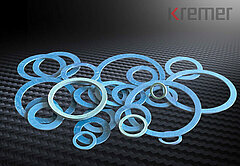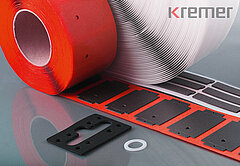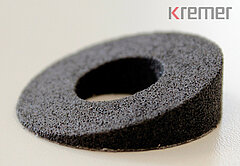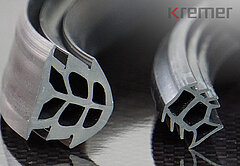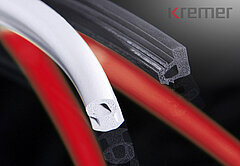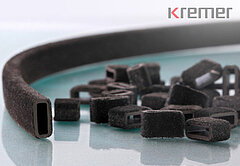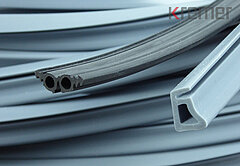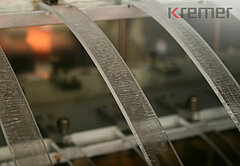Seals FAQs
-
Is silicone spray good for rubber seals?
Yes, silicone spray can be useful for rubber seals. Silicone spray is often used to lubricate, protect and extend the life of rubber seals. Here are some benefits of using silicone spray for rubber seals:
- Lubrication: Silicone spray provides excellent lubrication for rubber seals, helping them to move more easily. This is especially important to reduce friction and wear.
- Water-repellent: Silicone spray creates a water-repellent layer on the rubber seals that helps repel water and moisture. This can help make the seals less susceptible to cracking and damage.
- Protection against the effects of the weather: Silicone spray offers a certain degree of protection against UV radiation and other weather influences. This ensures that the rubber seals last longer and do not become brittle or fragile as quickly.
- Prevents sticking: Silicone spray often prevents rubber seals from sticking, especially on doors, windows or other moving parts.
It is important to ensure that the silicone spray is suitable for use with rubber and does not contain any harmful additives. Before applying it to a large area, you should make sure that it is compatible with the specific types of rubber in your seals, as some products may be better suited to certain rubber compounds than others, so always read the instructions on the product label.
-
Is Vaseline good for rubber seals?
Yes, petroleum jelly can be useful for rubber seals to lubricate them and prevent them from drying out . It forms a protective layer on the rubber that helps prevent moisture loss and maintains the flexibility of the material. This can be especially important in preventing rubber seals from becoming brittle or cracking.
However, it is important to note that not all types of petroleum jelly are the same . You should use a pure, white or transparent colored petroleum jelly that does not contain any additional ingredients or coloring. Colored petroleum jelly or those with additives could damage or discolor the rubber.
Before applying Vaseline to rubber seals, you should make sure they are clean to prevent dirt and dust from getting in. If you are unsure whether Vaseline is suitable for your particular application, you could also consider special rubber seal lubricants formulated for this purpose.
-
Is WD 40 suitable for rubber seals?
WD-40 is a versatile lubricant and rust remover, but it may not be the best option for rubber seals. Although WD-40 can help lubricate and protect rubber seals in the short term, it is not specifically designed for that purpose. Over extended periods of time, using WD-40 on rubber seals could cause the rubber to dry out or become damaged.
It is recommended to use a special rubber or silicone lubricant to extend the life of rubber seals. These lubricants are designed to keep rubber supple without damaging it. They also provide better protection against weather and other environmental influences.
-
Are sealing rings standardized?
Yes, sealing rings can be standardized. There are different standards that can apply to sealing rings, depending on the application and industry.
Some of the most well-known standards for sealing rings are:
- ISO standards: The International Organization for Standardization (ISO) has issued various standards for sealing rings, of which ISO 3601 is the most important standard for O-rings.
- ASTM Standards: The American Society for Testing and Materials (ASTM) publishes standards for various materials and products, including gaskets.
- DIN standards: The German Industrial Standards (DIN) also had standards for sealing rings, such as DIN 3771 for O-rings, which, however, has not been used for new projects for several years.
- ASME Standards: The American Society of Mechanical Engineers (ASME) publishes standards that may be relevant to sealing rings in various applications.
It is important to note that the exact standard may depend on the type of sealing material, application and specific requirements. If you require sealing rings, you should check the exact specifications and requirements of your application
-
What must be taken into account when using EPDM seals with LED lights?
When using EPDM seals, new challenges must be taken into account when dealing with LED lights . LED lights contain circuit boards in which silver-containing solder is processed. Due to the sulphur contained in EPDM cellular rubber, the silver triggers chemical reactions in EPDM. In the worst case, this sulphur migration results in the failure of the LED light source.
An EPDM cellular rubber manufacturer and supplier to our company has identified this problem and found a solution. It uses peroxides instead of sulfur for production. This causes a change in the network structure of the material, which in turn results in small differences in the tensile strength and elongation at break. However, these differences can be neglected because in sealing applications the decisive factors are the density, the compression set, the water absorption and the available Shore hardness, all of which are within similar tolerance windows.
Due to the higher density of the periodically cross-linked EPDM cellular rubber, seals made from this material are characterized by better resilience . This material is therefore preferred in the lighting industry.
-
What are flat gaskets?
As the name suggests, flat gaskets are flat sealing elements - often in the form of strips , rings , discs or frames . In medium to large series, these are usually stamped gaskets. They are mainly used in static sealing applications.
-
What are flat gaskets made of?
The general variety of materials used for flat gaskets is enormous. For example, there are flat gaskets made of paper, fiber and composite materials, foams, graphite, technical plastics or even rubber. As with all other gaskets, not only the design should be considered, but also the material selection - otherwise, in the specific application, cracks, swelling, embrittlement and other damage to the flat gasket may occur, and the gasket may fail as a result. Application factors such as the pressure conditions, temperature or the media with which the flat gasket comes into contact play an important role here .
For example, flat gaskets made of NBR are well suited for use in a temperature range of -20 to +100 °C and in contact with mineral oils, fuels, vegetable and animal oils, silicone oils or diluted acids and alkalis at room temperature.
However, if the flat gasket is to be able to come into contact with water , glycols and glycol-based brake fluids , acids or alkalis and at the same time has to have very good weather and ageing resistance , EPDM is the optimal sealing material to choose.
On the other hand, FPM is the right material when it comes to use at high temperatures, low gas permeability , very good resistance to aging, weathering, ozone and oxygen or contact with hydraulic fluids , fuels or essential oils. If the flat gasket comes into contact with coolants or good flame retardancy is required, CR (chloroprene rubber) is recommended as the sealing material .
-
How are flat gaskets manufactured?
The usual manufacturing processes for flat gaskets are punching , water jet cutting , plotter cutting and laser cutting . The choice of manufacturing process depends on the material, the material thickness and also the quantity of flat gaskets to be produced – ultimately, it is also an economic question . For small quantities or urgent requirements, the flat gaskets can be manufactured on a plotter or by water jet cutting, for example. For medium to large series, however, it makes sense to manufacture a tool and punch the flat gaskets.
Stamped seals
Sharp cutting tools are used when punching flat gaskets . These are shaped exactly like the desired flat gasket. The tool is pressed onto the flat base material with great force using a hydraulic press, which ultimately gives the flat gaskets their contours. Particularly delicate, deformation-prone punched parts can be left with the punching residues for better protection against deformation .
However, the kiss-cut process is recommended for faster assembly of flat gaskets with self-adhesive film . The advantage of this punching process is the rapid further processing of the flat gaskets, as the punched parts can be delivered on a roll at precisely specified intervals, free of punched grids, internal cutouts and leftovers. In this way, the punched flat gaskets can be easily removed from the protective or backing paper, either manually or automatically .
Plotter cutting of flat gaskets
Cutting via plotter is carried out using a movable blade which is attached to a CNC-controlled swivel head. An individual tool is therefore not required for plotting flat seals . Compared to other cutting techniques, smaller cutting tolerances are possible with plotter cutting, which is why the process is particularly suitable for very thin and soft materials . A so-called “kiss cut” is also possible here, whereby only the material is cut without damaging the carrier or protective film.
Water jet cutting of flat gaskets
As far as the manufacturing process is concerned, the softness and thickness of the material are not unimportant, as the cut surfaces of the flat gaskets can be more or less concave after punching, for example. If this is to be avoided for functional reasons, water jet cutting is a highly precise and more flexible alternative to the punching process . This process is particularly precise and allows the production of flat gaskets with particularly complex , delicate contours , extremely tight radii or even with precisely rectangular recesses . Water jet cut gaskets also have the advantage that they can be provided with particularly fine holes during production.
Laser cutting of flat gaskets
Laser cutting of flat gaskets is suitable for both prototype production and small series production . A particular advantage of this process is its speed and flexibility : by focusing and changing the light output, cuts can be made at different levels of the material, such as markings or engravings , kiss-cut cuts or cuts that completely sever the material .
Since no tools are required for laser cutting flat gaskets , there is no need to invest in tool costs. All that is required is CAD data in DXF or DWG format for the desired product. Contours can also be corrected with little effort based on CAD data , which is particularly advantageous in development processes.
Depending on the homogeneity of the material, the cutting pattern remains consistently high - no further processing of the cutting edges is required . Laser cutting enables parts to be produced that:
- have a low material thickness
- consist of materials that are available as rolls or in the form of individual sheets
- can be produced in a cutting area of approx. 300 mm x 300 mm.
The delivery forms of the flat gaskets are diverse and range from parts lined up on a strip to sheets and marked or engraved parts . Perforations or bending lines can also be created on the punched gaskets.
When it comes to the manufacturability of laser-cut parts , it is important to note that the cutting result depends on the material properties, thickness and density - the laser cut is a burn-off . Depending on the material, this can result in traces of soot on the finished part. Certain raw materials such as PTFE or PVC are not suitable for laser cutting , as toxic substances or gases can be produced when the cut edge burns off, or, as with metallic materials, significantly higher light beam energies are required to create a cut.
-
Where are flat gaskets used?
The range of applications for flat gaskets is very broad and extends from plant and mechanical engineering to the chemical and food industries , the automotive industry and pipeline construction . However, flat gaskets are generally used as static seals , often between two flanges, in pumps, motors or other areas where two contact surfaces meet. There they compensate for the unevenness of a flange connection and at the same time ensure the necessary sealing effect . If particularly high contact pressures prevail, flat gaskets with a correspondingly designed metal insert are often used. In the automotive sector, partially or fully coated flat gaskets are often found, the core of which is protected from chemical influences by a coating made of PTFE or metal, for example .
-
How do flat gaskets work?
Flat gaskets are pressed exclusively by external forces . They are not pressure-activated and therefore do not automatically adapt to the pressure to be sealed. Therefore, from a design perspective, a uniform surface pressure must be guaranteed over the entire surface to be sealed . This must always be locally higher than, for example, the pressure of a fluid in the system. If this minimum pressure is not reached - even if only in one place - the flat gasket fails. The pressure is applied via the flange surfaces , usually by means of screw connections . If the pressure to be sealed is lower, clamp connections are also sufficient.
-
How are flat gaskets installed?
When installing flat gaskets in flange connections, two variants are possible: arrangement in the main force connection or in the secondary force connection . This depends on the requirements placed on the flange connection. In the main force connection, the connecting force of the flanges is transmitted through the gasket . Therefore, when designing the flat gaskets, it must be taken into account that the applied sealing force achieves the required tightness over the entire service life. On the other hand, the risk of the gasket being pressed out or blown out of the sealing point must be minimized.
With a force shunt, the flat gasket is located in a groove and the applied force is bypassed by the gasket once it reaches a certain size . Here, it only performs the sealing function and does not also transmit the force, as is the case with a force main connection. This makes narrow sealing surfaces possible, with which a high surface pressure can be achieved. In addition, the flat gasket is protected from over-pressing and blowing out . At the same time, settling phenomena are minimized and media abrasion prevented .
-
What is a profile seal?
A profile seal - also called a "sealing profile", "sealing profile" or "profile" for short - is an endless seal made of one or more materials that has a characteristic cross-sectional profile. The possible geometries - and thus the areas of application for profile seals - are extremely diverse . They can therefore be found in many sectors and industries, but also very frequently in the private sector in a wide variety of applications.
-
How are profile seals manufactured?
Profile seals are manufactured by extrusion . Derived from the Latin "extrudere" for "to push out", the principle of the extrusion process is already clear from the term: a deformable material is continuously pressed through a shaping opening in so-called extruders under pressure and often at high temperatures. The opening - also known as a die, nozzle or mouthpiece - creates the desired geometry of the profile. It should be noted that the material pressed out through the mouthpiece under pressure relaxes again and therefore swells in the now pressure-free area. The swelling behavior differs from material to material, so the dies for different elastomer materials, plastics and thermoplastic elastomers must be adapted to the swelling behavior.
Extrusion produces bodies that can have any length. In general, the product itself is referred to as an extrudate. In addition to injection molding, as used for molded parts or injection molded parts, extrusion has established itself as an important process for producing plastic articles made of elastomers, thermoplastic elastomers and plastics.
-
How does the extrusion process for profile seals work?
A very simplified description is given using the example of a screw extruder : The pressure required to produce the profile is generated by the extruder screw located in the so-called screw cylinder. The nominal diameter of the screw cylinder and the outer diameter of the screw are almost identical. The drive, usually an electric motor with a gear unit, ensures the rotation of the screw.
If we focus on the extruder screw, we can divide it into three areas, each with a different purpose. In the so-called intake zone, which is located in the rear part of the screw cylinder, the material to be extruded - in the form of powder, granulate or feed strips, for example - is fed in via a funnel. This process is called " feeding ".
If several components are used for the extrusion of profiles, such as masterbatches (plastic additives in granulate form as colorants), their dosing must be particularly precise and reproducible. Depending on the control mechanism, a distinction is made between gravimetric and volumetric dosing.
The rotation of the screw now transports the material to the compression zone. Here it is further compressed by the reduced flight depth of the screw, which also builds up the pressure required for discharge. In the discharge zone , also known as the metering zone, a material flow that is homogeneous to the tool is generated.
When extruding elastomers, the processing parameters are the opposite of those used for plastics processing. When extruding plastics, the material is heated in the extruder and then cooled and, if necessary, calibrated after leaving the extruder and passing through the die. When extruding elastomers, the material in the screw is only heated to the point where it is liquefied.
After leaving the die, the shaped, tough strand is immediately exposed to heat (IR emitter, microwave or salt bath) to initiate vulcanization. Only at the end of the tempering section, during which no pressure is applied to the profile, is the elastomer material vulcanized into an elastic and endless strand profile.
The material continuously pressed out of the tool is then fed to the calibration unit in the next step . Calibration is a unit that is connected downstream of the extruder. Its function is to fix the still hot, molten plastic extrudate to the later dimensions. A vacuum is usually used for this purpose to ensure that the hot material comes into contact with the cooled inner wall of the caliber and cools down. Depending on the product, a distinction is also made between solid profile and hollow profile calibration.
During calibration, the still hot strand of polymer melt is cooled down to a temperature at which it is no longer possible to subsequently deform it. The profile strand is then completely cooled in the subsequent cooling section . In the last steps of the plastic extrusion line, the mostly rigid profiles are then stripped off and sawn to the required length depending on the end product. Extrudates made of softer materials can be wound or spooled depending on their rigidity.
As a rule, profiles are used as metre goods , cut into sections, glued together to form rings, butt-vulcanised or corner-vulcanised to form frames. If, for example, sealing frames are required, extruded continuous profiles are "vulcanised" together in the corners with an injection-moulded part to form frames.
-
[Translate to English:] Welche Profildichtungen gibt es?
As mentioned at the beginning, the variety of profile shapes and cross-sections is very large. It would be beyond the scope to list all the variants and combination possibilities. The selection ranges from simple, very common basic shapes such as
- round profiles
- semi-circular profiles
- C-profiles
- D-profiles
- E-profiles
- H-profiles
- T-profiles
- square profiles
from groove, frame, edge and insert profiles to special designs with individually designed geometries.
In addition, sealing profiles can be manufactured as hollow chamber, hose, solid rubber, foam rubber or multi-component profiles with hard and soft or foam rubber components.
Foam rubber , an elastomer made from chloroprene, EPDM , NR , NBR or similar synthetic rubbers, has a porous structure with predominantly open cells and a dense outer skin thanks to the propellant gases added during the manufacturing process . This gives it a high level of compressive elasticity and good recovery capacity . After stretching or compression, the material returns almost to its original state, which means that many tolerances can be bridged. What does not return to its original shape is referred to as compression set.
If, for example, a reliable, quick assembly of the profile is required and the closing forces of a lid, flap or other type of closure must be kept as low as possible, a solid carrier profile in combination with a soft foam rubber would be an excellent choice.
When installing softer or thinner profiles, there is a risk of so-called stretching , and thus unwanted waves or folds in the "last few meters". In this case, the installation of plastic threads as strain relief is recommended if the geometry is suitable. However, if additional stabilization , e.g. clamping or edge protection profiles, and reduced assembly effort is required, they can be provided with metal inserts made of stainless steel. In addition, profiles can be individually flocked, coated or equipped with hot melt adhesive or self-adhesive film.
Examples such as these show that, despite the variety of shapes, the choice of material must harmonize optimally with the design of the profile seal and its operating conditions and must be carefully considered in advance.
-
Where and how are profile seals used?
The range of shapes, cross-sections and geometries of profile seals is as wide as their areas of application. Typical industries in which rubber profiles are used include:
- machinery, plant and equipment construction
- energy, air conditioning and ventilation technology
- door, gate and facade construction
- construction industry
- medical technology
- container construction
- automotive industry
and many others. In addition to providing secure sealing , for example against gases, dust or liquid media, profile seals often serve additional functions: As edge protection , they reduce the risk of injury and/or prevent other types of damage. An appropriately designed profile seal can also serve the purpose of thermal insulation or noise protection , for example as a door and window seal in buildings or vehicles.
In vehicle construction, they are used as anti-creaking profiles or as door or window seals on trucks, cars or mobile homes. In the field of renewable energies, profiles are also used as rubber pads for laminate clamps and as module center clamps . And last but not least, profile seals protect the interior of many electrical devices from moisture, dust and dirt.
-
What materials are profile seals made of?
Since profile seals are required in so many different areas of application , the range of suitable materials and material combinations is also very large. Last but not least, the choice of material must be optimally adapted to the intended use.
First of all, sealing profiles can be made from all common rubber materials, such as
but also from soft PVC and thermoplastics and thermoplastic elastomers, TPE for short .
EPDM profiles, for example, have excellent resistance to chemicals, hot water, steam, polar solvents, as well as to weathering, aging and ozone. They also have excellent electrical insulation properties, as well as very good heat resistance and good cold flexibility. However, they have only a low resistance to aliphatic and aromatic hydrocarbons, e.g. fuels, petrol and mineral oil.
In contrast, NBR profiles are resistant to mineral oils and fats, to embrittlement and to the effects of heat, cold, weather and aging after the addition of ozone and anti-aging agents. However, NBR profiles are permeable to vapor and gas and are not resistant to acids, bases, ketones and alcohols.
Silicone profiles, on the other hand, are ideal for applications that require literally flexible material properties. This includes, for example, a wide temperature range of -55 to +210 °C. Silicone profiles also have good electrical insulation properties, are food-safe and also resistant to ozone and weather influences.
In the case of profiles made of soft PVC, the properties depend heavily on the plasticizers added during the manufacturing process . These can specifically change the material properties and be adapted to the intended use. It is therefore difficult to make a general statement about the properties of soft PVC. However, it can be said that thanks to optimally selected stabilizers and high-quality pigments, very colorfast and weather-resistant PVC formulations can be achieved, which can be used outdoors for several years without any problems. Profiles made of soft PVC are also flame-retardant and self-extinguishing. The degree of this property can also be adjusted depending on the amount of plasticizer used, as can their chemical resistance.
In order to avoid stress cracking , when using profiles in combination with transparent plastics such as polycarbonate (PC) or polymethyl methacrylate (PMMA) (better known under the brand name Plexiglas® or the term acrylic glass), materials that are compatible with them must be used. Stress cracks in plastic panes or similar objects are known in technical jargon as "silverfish" due to the way they look when cracks form. To avoid their formation, the influence of the elastomer mixtures must be assessed individually in a short-term stability test.
-
How are hose rings made?
Hose rings are cut from the endlessly extruded hose and are therefore, in contrast to molded parts, burr-free and have smooth inner and outer surfaces as well as absolutely sharp edges.
For sealing rings or hose rings with thinner walls and greater cutting lengths/heights, endless hoses or approx. 1 m long hose pieces are produced in advance. These are pulled onto mandrels in a further work step . Mandrel-made hose rings are coated with talcum powder on the inside so that they can be pulled onto the mandrels before and off the mandrels after vulcanization in a steam boiler (here mandrels approx. 1.2 m long). The mandrel-made hose rings are cut precisely to the desired length/height of the hose ring . This manufacturing process means that hose rings generally have a particularly good compression set . To increase the pull-out forces of talcum-coated hose rings, they are then washed and delivered to the customer.
-
Where are hose rings used?
The areas of application for hose rings are very diverse and range from the automotive, food, electrical or chemical industries to the sanitary sector and the construction industry through to mechanical and housing construction . Here they are used, for example, as insulation, damping, sealing or protective elements.
In the automotive sector, they are used for noise or vibration insulation, among other things . In the sanitary sector, they are used to seal aerators in fittings. They are used as strain relief in cable glands in machines or electrical devices.
Of course, different requirements are placed on hose rings depending on their intended use . In the electrical sector, where they are used in PG cable glands or connectors, for example, there are strict criteria for fire behaviour, but also for mechanical properties, freedom from burrs and compliance with narrow dimensional tolerances .
More general factors that must be taken into account depending on the application area are UV resistance, compression set or the correct choice of material with regard to the required resistance to various media.
It is easy to imagine that hose rings for use in the food industry require a different material than those that come into contact with fuels or mineral oils. It is therefore important to us that you describe the application to us so that we can select the right material.

